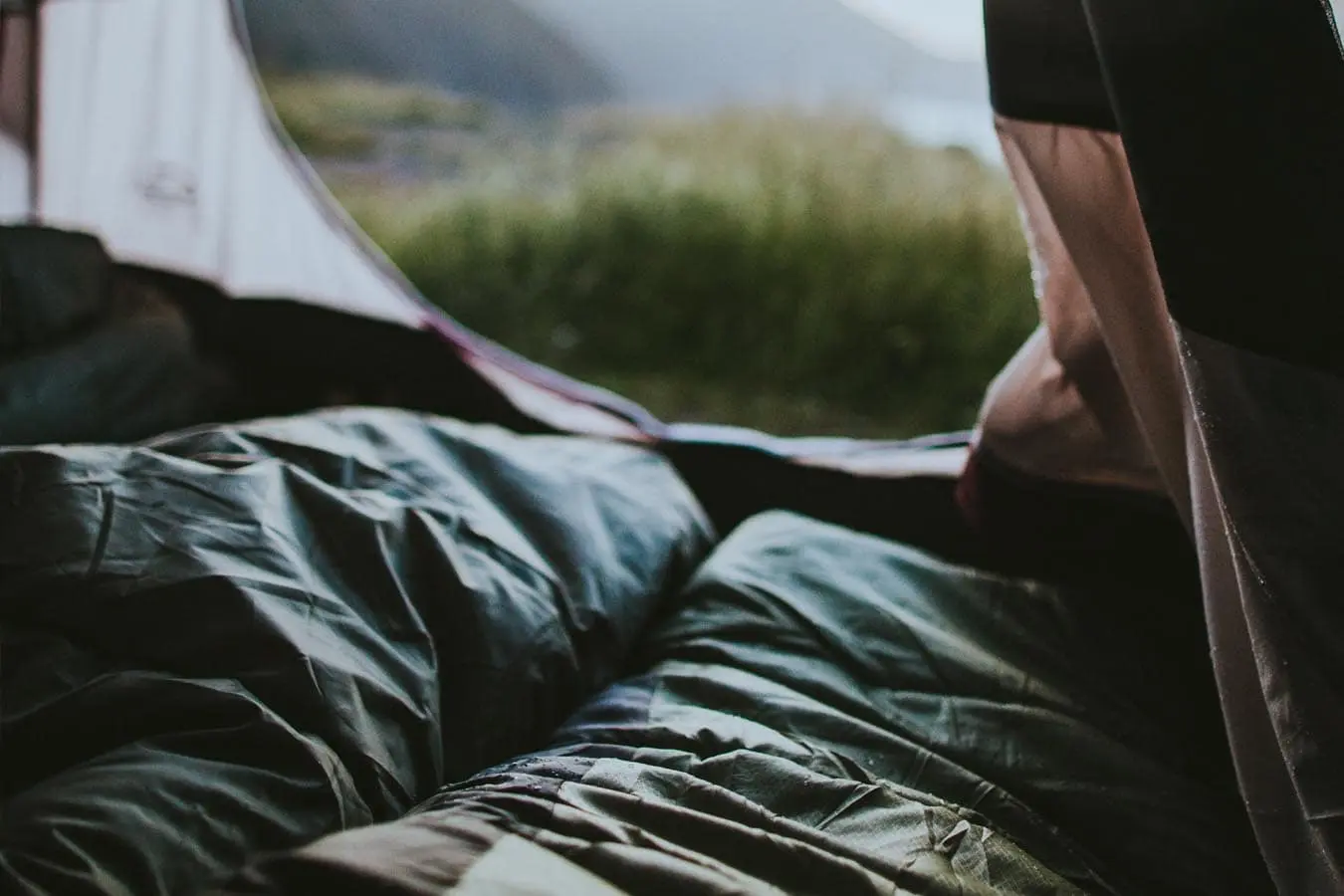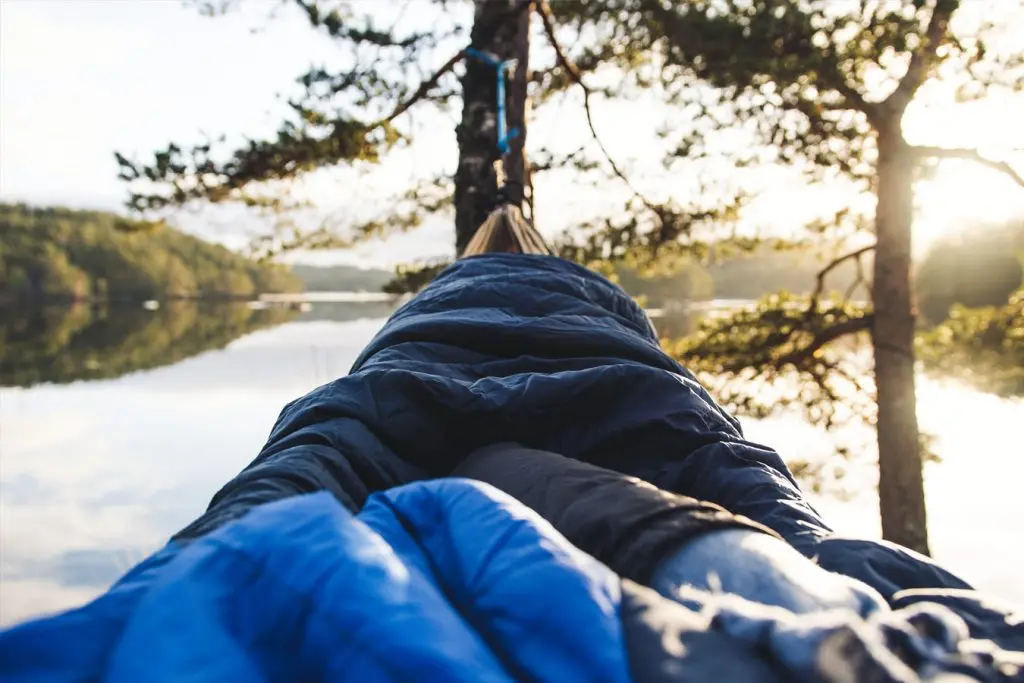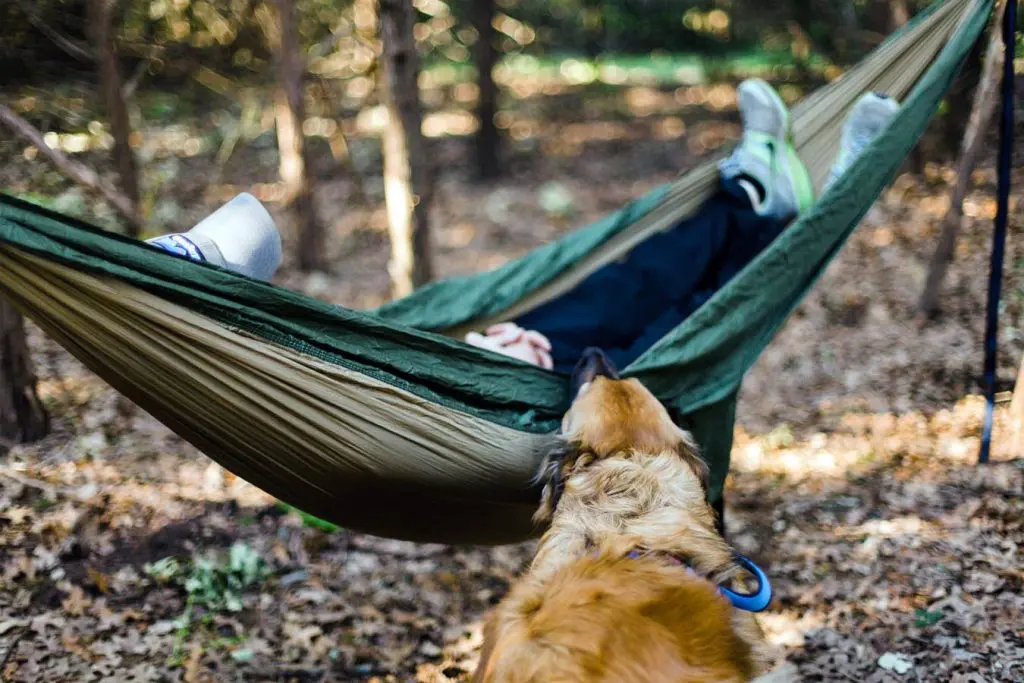Camping in cold weather is an area that requires a lot of planning and preparation, and as avid campers know, ensuring that you keep warm should be at the very top of that list.
Fortunately, when armed with the right knowledge and equipment there are many ways to keep the cold out, both with and without electricity.
To help with this, here we have complied a list of 26 of our favourite tips and tricks that will help protect both you and your tent from even in the coldest of conditions.
How to stay warm in a tent
A study conducted a few years ago found out that cold-related deaths were 20 times higher than those caused by heat. While this study wasn’t specifically camping related, it helps illustrate just how great the potential risks associated with exposure to cold weather can be.
If you intend to spend extended lengths of time in the cold, it can literally be a matter of life or death.
Here are 26 tips that will help you keep your tent warm with or without electricity.
01 – Heat your tent with hot water – hot water bottle
This is an age-old trick that a lot of experienced campers use. The greatest thing about it is that it relies on the true spirit of camping: improvisation and resourcefulness.
For this to work, you will need several hardened bottles. You will also need a heat source of some sort, such as a fire, and a large pan for boiling water.
Heat some water to near boiling point. Once, the water is hot enough, transfer it to the bottles, which can either be strong glass bottles or hardened plastic bottles. As long as they can hold hot water without falling apart, they should work.
Spread these bottles around inside the tent. They will the entire tent warm until morning. This method is so effective that the bottles will actually still be warm in the morning.
02 – Use heated stones to keep the tent warm
This method is quite similar to using water bottles.
Choose some stones and place them around the fire. Do not throw them into the fire because they’ll be hard to remove. To ensure they do not burn the tent, wrap them with a piece of cloth.
Next, place the stones strategically within your tent at least one hour before you sleep. The best spots are those furthest from you so you can avoid touching them.
The warm stones will give you heat for about four hours. Although they do not last as long as water bottles, they give off a lot more heat.
03 – Insulate your tent – Reduce Ambient Space
This method is very simple, with the idea behind it being to reduce the extra empty space around the tent where cold air can collect.
First, if there’s more than one person in the tent, bring all the sleeping bags together. Place them all in one central location. Secondly, lay your gear and sacks all around the interior of your tent to add more insulation.
Finally, secure a space blanket on the tent ceiling. You can do this using duct tape. If you see a lot of moisture in the morning, however, you can ignore this method.
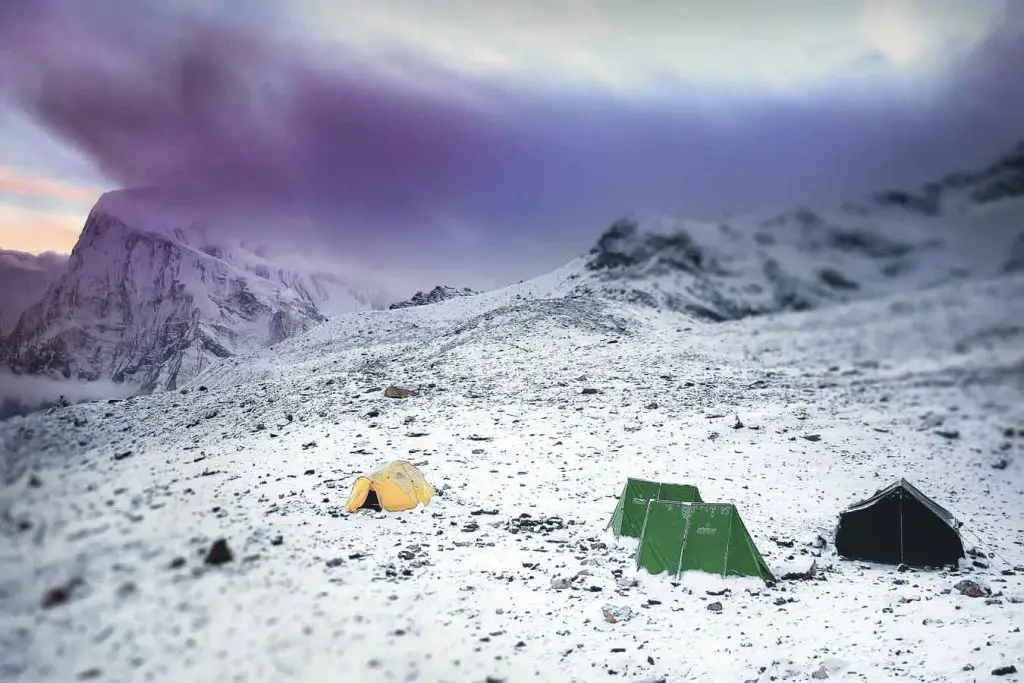
04 – Electric / portable heaters
Today, there are a lot of innovative tent heating techniques that you can take advantage of. Using electric heaters falls in this category.
Your electric heater will need about 2 square feet of space around it. Place it in a position it won’t be knocked down, ideally on a platform. The heater should be secured to the platform.
Connect it to a source of electricity, usually, through an extension cord. The cord should also be secured with duct tape to avoid getting wet. Ensure the cord’s wires are not exposed and the cord is placed away from human traffic to avoid tripping.
That’s all there is to it!
05 – Electric blanket
This is another method that requires electricity to work. However, this method is targeted because it only heats the person using it, although it might warm a smaller tent depending on its power.
Electric blankets come in regular blanket sizes and specific designs such as King Sizes, car blankets, food blankets and so on. They are powered by an electric source. All you have to do is plug them in and cover yourself with them.
06 – Underfloor heated carpets
Technically, underfloor heated carpets are just specialized electric blankets, working with the same principle. However, they take a different approach.
To use them, simply place them on the tent floor. You can still use your sleeping bag with underfloor heated carpets.
To ensure they work even more effectively, you can have a heat-reflecting mat below the heated carpets. That way, the cold moisture from the ground will not get into the tent.
07 – Insulate your tent with a tent carpet and/or rugs – layers underneath
Quite a significant amount of heat is lost through the ground. A carpet or rug offers a layer of insulation when placed on the floor of your tent. Although tent carpets do not come cheap, they can add a bit of homely coziness to your trip.
Alternatively, you can invest in a rug. However, most of them are not waterproof, so ensure that you lay them on a waterproof surface to prevent them from getting damp.
08 – Wear suitable clothing – don’t wait until you feel cold to layer up – thermals
Ideally, you want to dress up in three layers as you go cold-camping; the inner, middle and outer layer of clothing. A lot of people think that warmer clothes are what keep us warm in the cold. In reality, clothes only keep us warm if there is enough space between them for air to pass through. The air gets trapped between your skin and the fabric, it gets warmed up, and in the process slows down the rate at which your body loses heat.
Heat gets conducted by heat conducting materials, but it travels even faster through air. This is why when you go out to buy clothes for the cold, you should not only look for the material bulkiness but also look at the material itself. For example, cotton is not a great material for the cold because it loses air too quickly.
09 – Here are a few more tips you should remember when layering up:
- Wear a hat all the time.
- Wear thermal innerwear
- Remember to wear three layers of clothing
- Put on synthetic socks
- Always cover your face like you are skiing.
10 – Don’t get wet
Above all else, make sure you don’t get wet when you are out camping in cold weather. Also, ensure your gear does not get wet. How do you avoid getting wet?
- Store your gear and extra apparel in waterproof bags in your backpack.
- Wear waterproof gloves and carry extras to use if they get wet.
- Wear waterproof boots
- Carry extra clothes for when the one set gets damp from hiking or outside activities. Ensure the floor of the tent is not wet before tucking yourself in.
- Avoid extremely wet weather when you are out camping. You can stay within your tent till the blizzard or rain subsides.
11 – Don’t go to bed cold
There are a lot of potential risks associated with going to bed cold. To avoid going to bed cold you should prepare early. How can you do that?
Well, first of all, ensure that the sleeping bags are readied beforehand. Next, you need to warm the sleeping bag through the various methods we have highlighted here. It is also a good idea that the tent as a whole is also warm.
Finally, don’t sleep on an empty stomach. Eat food that is full of calories and slow burning qualities, such as chocolate and nuts.
12 – Use sleeping bag liners
You can keep yourself even warmer by using a sleeping bag liner. Although there are some sleeping bags that can be quite warm, sleeping bag liners have been specifically designed to trap the heat within your sleeping bag, increasing the overall comfort of the bag.
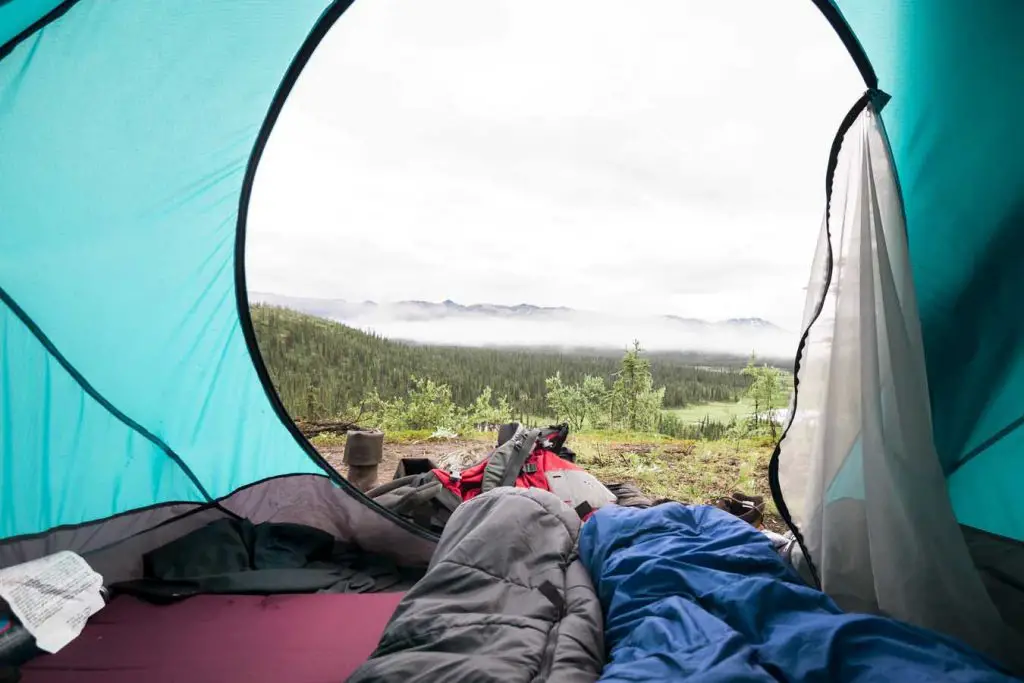
13 – Use disposable heat packs
Disposable heat packs can be extremely useful in a number of scenarios. For starters, when you place them in your sleeping bag as you sleep, they will go a long way in keeping you super warm and cozy no matter how cold the weather is outside.
Additionally, they are also quite useful when hiking in the cold. Tucking them in your clothes will keep you warm throughout.
14 – Use a suitably sized tent – not too large
When it comes to tents, size is very subjective. There is no definitive perfect tent size, everyone has a different opinion on what works and what doesn’t. Nevertheless, a tent that is not too large will be most effective for cold weather, for the simple reason that it is better at heat management.
Therefore, learn to balance your need for space with your heating requirements.
15 – Use the correct type of sleeping bag
Before you go camping in the cold, you need to make sure that your sleeping situation is well-taken care of. There are various kinds of sleeping bags, and you need to get the one that is rated and insulated for camping in the cold.
Aside from that, you also need to get an appropriate sleeping pad. Sleeping pads can be a little contentious, because there is some controversy surrounding their proper placement in camping circles.
There are two options when it comes to placing your sleeping pad: either underneath or inside the sleeping bag. Here are several reasons why putting a sleeping pad inside the sleeping bag is superior.
If they are placed underneath, they tend to shift a lot as you sleep. They also minimize cold spots when inside the sleeping bag. On the other hand, there are some wider pads that are difficult to fit in your sleeping bag.
Either way, it is up to you to find what works for you. Get the correct sleeping bag and an insulated closed-cell foam sleeping pad for camping in cold weather.
16 – Take extra blankets
It doesn’t hurt to come prepared with some extra blankets for use. One blanket might get damp or even wet, you’ll need another one for replacement.
Occasionally, people forget to carry along extra blankets for colder nights. When it gets extremely cold, they are literal lifesavers.
17 – Choose the right camping spot
First of all, regardless, of the spot you choose, it’s important to learn how to secure your tent against the wind.
That said, here is how to choose the right camping spot:
- Check the weather forecast, and confirm the strength and direction of wind before setting base.
- Remember to carry the proper gear for securing up your tent
- Choose a sheltered campsite; they might not offer the best view but at least they protect against strong winds.
- Go for natural windshields; once you confirm the direction of the wind, place your tent in against trees, hills or cliff protections.
- Pitch tent in the right direction. The door should be facing the direction against the wind.
- Pitch your tent when it is less windy.
- Pitch your tent properly, there are best practices such as the use of pegs and arranging your tent properly.
18 – Eat sufficient calories and drink hot drinks
You need to eat lots of nutritious food that is high in calories. Also, stay hydrated and drink hot drinks to stay warm.
Carry food that is easy to prepare. You can easily prepare foods such as sandwiches, typically eaten with a mug of hot chocolate, tea or even some soup. Do not shy away from fatty foods as cold weather tends to burn more calories in your body. Meat and cheese are particularly great for this reason.
Lastly, you can enjoy dry treats as well as few crackers or even fruitcakes.
However, it is good to mention that this is just a sample diet, you can work with various combinations depending on what is available to you.
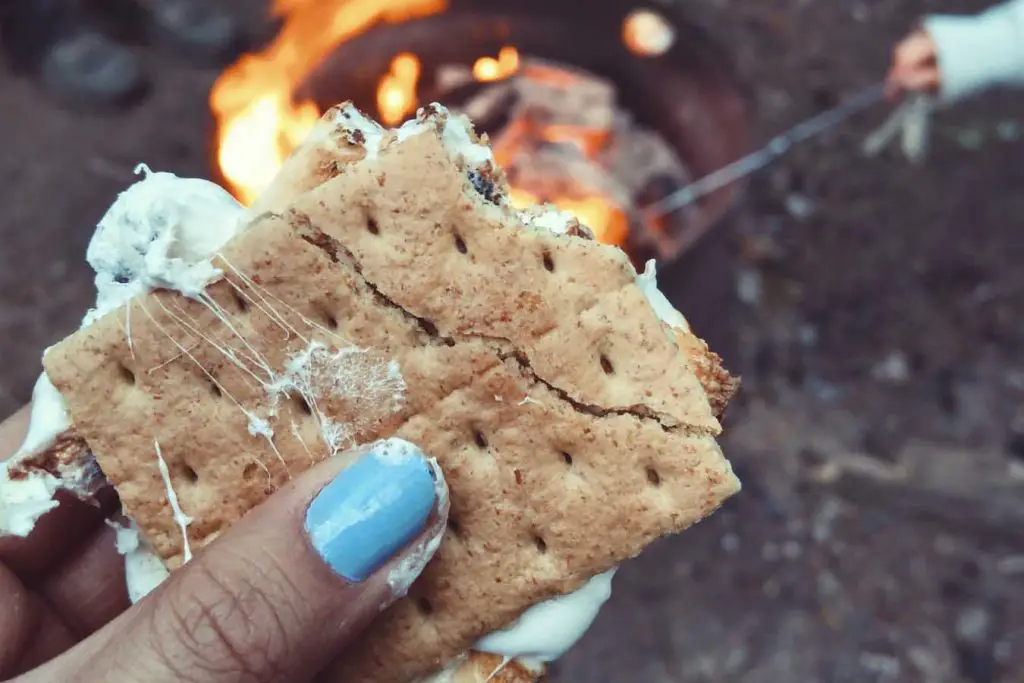
19 – Get active
This is another great way to keep warm in your tent. When you are active your body is warmer. Don’t wait until you get cold. You can even layer up and work out for that extra toasty feeling.
Stay active by doing some activities such as jumping. As long as you can get yourself to sweat, you will be on the right track.
20 – Insulate your water bottles
When it’s cold or when you’re in high altitudes, there is the potential risk of dehydration. You need to constantly drink water. However, your body does not handle freezing water well. I will actually drop your body temperature, making raising it back to normal really hard.
There are specially designed insulated steel bottles that you can carry along to keep water at a safer to drink temperature. Some commercial air coolers also maintain heat with a 95% retention capability.
Once in a while, you should keep on dehydrating your body by drinking something warm such as soup or water.
21 – Be prepared and pack the right camping gear
Not having the right gear can ruin what otherwise would have been a perfect camping trip. There are a number of things that you shouldn’t leave behind at all costs. This includes a strong tent, a well-insulated sleeping bag, a sleeping pad, and a tent stove. You should also carry a heater or bottle, and some food.
If you have other people with you just multiply the essentials with the number of people you’ll be having during the trip.
Furthermore, you should not forget to carry cold season clothing such as puffy coats, waterproof jackets, socks, gloves, and sunglasses.
22 – Dry clothes and gear – store in a dry bag
Be sure to carry enough clothes to be comfortable as you camp. Take into account the fact that some clothes might get wet, so bring several changes with you. Never wear or go to sleep in anything wet when it is cold out.
All your clothes should be stored in a dry bag that will always be kept in an elevated spot within your tent.
23 – High R-value sleeping mat
Having a high R-value sleeping mat is essential when camping in the cold. Sleeping mats come in various sizes and styles, ranging from rolling up foam pads, pads with ridges, and aluminized pads for better insulation. The aluminized sleeping mats help reflect any available heat towards you.
Choose an insulated sleeping mat because it will offer extra thermal protection. Some people go for all-weather sleeping mats that can be used even in the summer. Although these work well, they are not as good as insulated ones that have been specifically designed for cold weather.
The one thing that should help inform your decision is R-Value. R-Value indicates a sleeping pad’s insulation ability from the tent’s floor or ground. This value runs on a scale of 0-6. The higher the number the higher the R-value thus the higher the ability to keep you warmer.
If you are going to be camping in the cold, choose a sleeping mat with an R-Value of 5 or 6.
24 – Remove morning frost from your tent
You’ll notice that water vapor tends to condense on the tent interior. The downside to this is that when the ice melts it will wet your gear.
Luckily, there is a workaround to this. You can control the morning frost by packing your gear inside plastic bags. You can also sweep out the ice particles before they melt.
If there is the need, you should dry out your gear every morning. If you have some pleasant sunshine and wind in the morning, you can invert your tent and let it naturally get dried out.
25 – Light a campfire
A campfire is the universally recognized symbol of camping. Some people will even go as far as saying that it is not really camping if there is no campfire.
Campfires are useful in two ways. One, the campfire is used for warming yourself directly or through warming hot water bottles or even stones. Secondly, the campfire can be used to cook or warm food which is an essential ingredient in a great camping experience and for keeping you warm.
Sometimes, if you have the level of experience to do it, you can even set up a tent in a spot when a fire has already died down to take advantage of the residual heat.
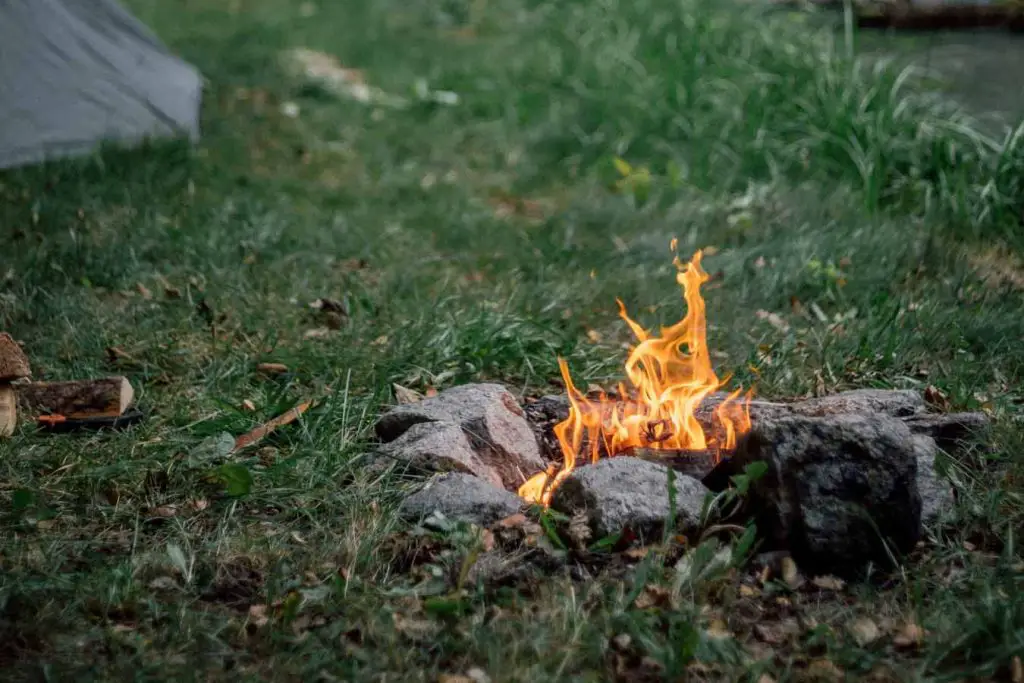
26 – Protect your electronics from the cold
Cold weather has a way of draining your battery or even damaging your electronics permanently.
If you go camping with electronics, which is kinda expected especially with smartphones, keep them at the bottom of your sleeping bag. And not just electronics, you can keep away anything that you feel might freeze from the cold weather.
By default, all electronics can only fully function at a specified maximum and minimum temperature. Anything past that will damage them. Always confirm this limit with your electronics before heading out with them.
What NOT to use to heat your tent
Tent stove without flue
Tent stoves are usually designed with a flue to pass the smoke out of the tent into the air where people cannot breathe in the gases. Safety is enhanced through following the right installation measures such as using them in a well-ventilated area.
You should also follow the manufacture’s guidelines.
Maintain a clean flue at all times. Burn only dry wood to prevent clogging up the flue. As a precaution, you should never go to sleep when the tent stove is open.
Open fire
Because of the risks involved, you should not use an open fire in a tent. For one, the open fire is uncontrollable and might burn materials in the tent including the tent canvas.
Even if the tent is high enough and well ventilated some woods produce sparks that might burn gear, tent or clothes.
If you burn woods containing tar, the entire tent will be filled with thick smoke. The most ideal situation when using open fire is to find a way to control it. For example, the fire can be lit in a firebox placed on a platform.
Heaters during the night
Recently, the Campers Coalition warned that using heaters overnight poses threats to campers. They warned that there is a higher risk of carbon monoxide poisoning, especially during the night. They added that outdoor tent stoves and heaters also emit this life-threatening gas.
When you use heaters at night you become vulnerable and unaware when carbon monoxide poisoning happens. Carbon dioxide symptoms include drowsiness, headaches, feeling dizzy, confusion and general weakness.
Conclusion
So, there you have it! With these 26 great tips, you will be able to camp comfortably in almost any weather.
Extreme cold can be very dangerous to anyone, so keeping yourself safe and protected is the best way to ensure that your entire camping experience remains one awesome memory.

